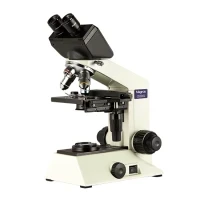
Magnus Microscope CH20i
The Magnus LED Microscope CH20i is a type of light microscope designed for various educational and research applications.
Key Features:
1. LED Illumination:
- Light Source: The microscope uses LED illumination, which provides bright, clear light for viewing samples. LED lighting is energy-efficient and has a more prolonged lifespan compared to standard incandescent bulbs.
- Adjustability: LED brightness is usually adjustable, allowing for optimal lighting conditions for different types of specimens.
2. Optics:
- Objective Lenses: The CH20i typically features multiple objective lenses, allowing for different magnification levels. Common configurations include 4x, 10x, 40x, and sometimes 100x objectives.
- Eyepiece: It generally comes with a wide-field eyepiece, often with a 10x magnification, providing a clear and comfortable viewing experience.
3. Magnification:
- Total Magnification: The total magnification is calculated by multiplying the objective lens magnification by the eyepiece magnification. For example, using a 10x eyepiece and a 40x objective lens gives a total magnification of 400x.
4. Mechanical Stage:
- Stage Control: The microscope is equipped with a mechanical stage for precise movement of the slide, making it easier to locate and observe different areas of the specimen.
5. Focusing Mechanism:
- Coarse and Fine Focus: It typically includes both coarse and fine focusing mechanisms for accurate and smooth adjustments.
6. Build Quality:
- Durability: The CH20i is designed to be robust and durable, suitable for classroom or laboratory use.
- Ergonomics: It often features an ergonomic design for comfortable use during extended periods.
7. Additional Features:
- Condenser: It may include a condenser with an adjustable aperture diaphragm to control the light and enhance image quality.
- Filter Holder: Some models come with a filter holder to use different colour filters for enhancing contrast or special applications.
Applications:
- Educational Use: Ideal for use in schools and universities for teaching purposes.
- Research: Suitable for basic research in laboratories.
- Clinical: Can be used in clinical settings for examining samples.
Advantages of LED Illumination:
- Energy Efficiency: LED lights consume less power compared to traditional bulbs.
- Long Life: LEDs have a more extended lifespan, decreasing the need for frequent bulb substitutes.
- Stable Light: Provides consistent light without the flickering that can sometimes occur with other light sources.
